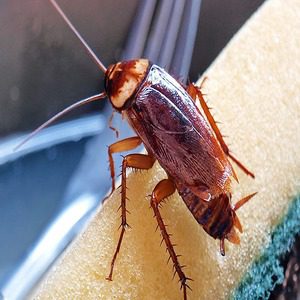Wolverine Pest Control Advice From The Experts

How to Get Rid of Roaches Permanently. Cockroach Types, Life Cycle, Removal & Prevention:
Want to learn how to prevent cockroaches? Roaches are notoriously persistent pests that can be challenging to eliminate. If you want to get rid of roaches effectively, it’s important to understand their behavior and explore the treatment options available. With the right knowledge and approach, you can address an infestation quickly and efficiently.
What Causes Roaches?
As a homeowner or renter, you play a crucial role in preventing roach infestations. Several factors can attract roaches, and by being aware of them, you can take proactive steps to keep them at bay:
- Food: The key to keeping roaches at bay is maintaining a clean environment. Leftover food, crumbs, and spills that aren’t cleaned up provide an easy meal for roaches. The more meticulous you are in cleaning up, the less attractive your home becomes to these pests.
- Water: Roaches need moisture to survive. Dripping faucets, leaking pipes, and even pet water bowls can serve as water sources for them.
- Uncovered Trash: Trash cans that are left open or have loose-fitting lids can offer roaches both food and shelter.
- Hiding Spots: Roaches love clutter. They’ll hide in anything from cracks in walls to stacks of cardboard boxes.
How Roaches Get Into Your Home
Roaches are skilled at finding ways into buildings. Here are some of the most common entry points:
- Doors and Windows: Properly sealing doors and windows, or replacing aging or damaged weather stripping, can make it more difficult for roaches to get inside. For example, using silicone caulk to fill in gaps can be an effective solution.
- Pipes and Vents: Cracks or gaps around plumbing and vents provide perfect roach access routes. These pests can also travel through pipes and ducts to move between apartments in multi-unit buildings.
If you’ve ever spotted cockroaches darting across your floor or crawling up your walls, you know the sheer panic they can cause when they emerge from hidden corners or food storage areas. While these pests are common in SE Michigan, that doesn’t make them any less filthy. On top of being unpleasant to see, cockroaches pose serious health risks to you and your loved ones, including allergies, asthma, and the spread of harmful bacteria.
Dependable Residential Pest Control
Call for a FREE quote over the phone! (517) 999-5008
Tips for Getting Rid of Cockroaches:
Want to keep cockroaches from invading your home or business? This is why it’s crucial to seek professional cockroach removal and pest control in Lansing, Holt, and Jackson, Charlotte, MI, Mason, Dimondale, Potterville, Grand Ledge, MI and nearby areas. Here are some effective
Cockroaches Control steps you can take to help prevent Cockroach infestation:
- Maintain Cleanliness: Pay special attention to cleaning any areas where food is stored, prepared, or consumed. Promptly clean up crumbs, spills, food scraps, and garbage. Roaches will eat almost anything!
- Sweep and Mop Frequently: Regularly sweep and mop floors to eliminate debris that attracts cockroaches. Be sure to clean under and inside machines, appliances, and other equipment.
- Remove Moisture Sources: Wipe up spills immediately and repair any leaking pipes or appliances, as cockroaches are drawn to moisture.
- Inspect Incoming Shipments: Carefully check delivery boxes and packaging for droppings and signs of live or dead cockroaches before bringing them inside.
- Seal Entry Points: Caulk and seal cracks, holes, and gaps around doors, windows, and walls to keep cockroaches from finding easy ways in.
- Keep Lockers and Storage Areas Clean: Regularly inspect and declutter employee lockers and storage spaces. Cockroaches thrive in cluttered environments.
- Store Food Properly: In kitchens and food prep areas, keep all food in sealed, airtight containers.
- Practice Proper Waste Management: Empty and clean trash bins frequently. Never let garbage overflow or accumulate on the floor.
- Trim Vegetation: Keep plants, bushes, and trees at least two feet away from your building to reduce potential cockroach hiding spots.
- Monitor Regularly: Set up a routine inspection and monitoring program using insect traps and regular checks for signs of pests.
Health Risks of Cockroach Infestations
Cockroaches are opportunistic scavengers that can transmit bacteria like Salmonella, Staphylococcus, and Streptococcus, parasitic worms, and pathogens. Their droppings and body fragments can also trigger allergic reactions and asthma, especially in sensitive individuals.
Cockroach Removal and Prevention
Dealing with cockroaches can be tough—especially in large infestations. While traps and sprays may help control small numbers, long-term removal and prevention are best handled by pest control professionals like Wolverine Pest Control Near You.

The Cockroach Life Cycle: From Egg to Adult
While various cockroach species differ in appearance, habits, and behavior, they all follow the same basic life cycle: egg, nymph, and adult. Yes, even cockroaches have an awkward adolescence!
Egg: Female cockroaches produce eggs encased in tough, protective capsules called oothecae. Depending on the species, the female may carry these oothecae with her or hide them in crevices, voids, or behind cabinets. The number of eggs per capsule varies by species and can range from 10 to 60. Similarly, a single female may produce anywhere from 5 to 30 egg cases over her lifetime.
Nymph: Nymphs are young cockroaches that resemble smaller versions of the adults but are not sexually mature and may lack features like wings. As they grow, nymphs go through several molts, shedding their exoskeletons each time.
Molting: The molting process — where nymphs shed their outer layer to grow — can vary, sometimes occurring up to 13 times over a period of 18 months, depending on the cockroach species.
Adult: After the final molt, the cockroach emerges as a fully mature adult, capable of reproduction. Adult cockroaches usually live between six months and one year.
Types of Cockroaches
What Do Cockroach Egg Cases Look Like?
Cockroach egg cases are actually visible to the naked eye. They’re typically reddish-brown to dark brown and range from 5 to 13 mm long, depending on the species. Despite their visibility, these egg capsules often go unnoticed because they’re hidden in tight or out-of-sight spots like behind picture frames or underneath furniture. Discovering one of these egg cases is a strong indicator of a cockroach infestation in your home. Cockroaches can be tricky to identify, mainly since they differ in appearance and egg-laying habits.
Reviews from Real Customers
What Do Baby Cockroaches Look Like?
Baby cockroaches, known as nymphs, hatch from eggs after an incubation period that typically ranges from 20 to 60 days, depending on the species and environmental conditions. When they first emerge from the egg case, nymphs are white in color but quickly darken to a deep brown as their outer skin hardens.
Nymphs resemble tiny, wingless versions of adult cockroaches, though their coloration is often lighter. For example, German cockroach nymphs—a common and highly invasive species in Canada—tend to be darker than adults and display pale, longitudinal stripes running down their backs. Here’s a rundown of the most common cockroach species you might encounter:
German Cockroach
Description: Light brown with two dark stripes across the back of the head (pronotum), the German cockroach measures about 14 to 16 mm (roughly half an inch) and is one of the smallest common roach species. German cockroach
Key Details:
The most widespread and significant indoor cockroach in Canada.
It reproduces rapidly: Females carry egg capsules until right before hatching, with up to 50 nymphs emerging from one capsule.
A female can produce 4–8 egg capsules in her lifetime, leading to fast population growth.
Infestations often consist of about 75% nymphs.
German cockroaches communicate by depositing pheromones where it’s safe to gather.
Prefer warm, humid environments with steady access to water and hiding spots.
American Cockroach
Description: The largest indoor cockroach, American cockroach can reach up to 54 mm (over 2 inches) in length and are reddish-brown in color.
Key Details:
Egg cases typically contain 14–16 eggs.
Nymphs go through up to 13 molts before becoming adults.
American cockroaches tend to live alone but can be found in large numbers in sewers and facilities.
Prefer temperatures between 70–80°F.
Common in pipes, food processing plants, and other moist environments.
Brown-Banded Cockroach
Description: Named for the two light brown bands across their wings, brown-banded cockroaches are similar in size to German cockroaches.
Key Details:
Egg cases are glued in hidden spots on furniture, walls, and ceilings.
Populations can build quickly.
Males can fly; females do not.
Prefer warm, dry areas like cabinets, behind appliances, and inside furniture.
Oriental Cockroach
Oriental cockroach Description: Oriental cockroaches are dark reddish-brown or black and have a shiny exterior. They grow up to 25 mm, about twice the size of German or brown-banded roaches.
Key Details:
Produce fewer offspring (up to eight cases per season).
Slower and less agile than other species.
Prefer cool, damp locations: basements, sewers, and crawl spaces.
Rarely found above ground level.
Smoky-Brown Cockroach
Description: Smoky-brown cockroaches have a shiny, brownish-black color and are capable fliers.
Key Details:
Females usually produce up to 10 egg cases, each with about 20 eggs.
Development time varies greatly with temperature (160–716 days).
Attracted to lights; may fly indoors if exterior lights are on.
Prefer moist, protected outdoor spots but can enter attics and basements.
Wood Cockroach
Description: The Pennsylvania wood cockroaches in Michigan are commonly light yellowish-brown and measure 22–30 mm.
Key Details:
Both sexes have wings, but males are stronger fliers.
Live in or around wood (tree bark, piles of firewood).
Often, they enter homes via firewood and stay in moist, warm hiding places.
Feed mainly focused on decaying plant material.
Dependable Residential Pest Control
Call for a FREE quote over the phone! (517) 999-5008
Cockroach Behavior
Cockroaches are highly adaptable, fast-moving, and prefer darkness. Their behavior has helped them survive for millions of years.
Can Cockroaches Fly? Many cockroach species can fly, but capabilities vary. German cockroaches rarely fly; smoky-brown cockroaches are strong fliers. Male brown-banded and wood cockroaches can fly, while Oriental cockroaches cannot. Flight involves unfolding thin back wings for actual flying while the thicker front pair rests on their backs.
Can Cockroaches Make Noise? American and German cockroaches are not known for making distinct noises. The “crunch” when stepped on or a fluttering of wings in large populations are the most common sounds. However, the Madagascar hissing cockroach makes an authentic hissing sound for communication, and some Australian species create vibrations to attract mates.
Do Cockroaches Bite? Bites are sporadic and usually only happen if food is scarce and infestations are severe. Cockroaches are omnivores, but most homes have plenty to eat.
Where to Find Cockroaches in Homes and Buildings
Cockroaches are nocturnal and prefer warm, dark, and moist hiding spots. You may find them in:
Hidden spaces (wall voids, ceilings, under floors)
Behind or inside appliances and electronics
Food preparation areas
Lockers, closets, and laundry areas
Storage spaces and waiting areas
Signs of a Cockroach Infestation
Fecal droppings: Small cockroaches leave specks resembling ground coffee; larger ones leave droppings similar to those of a baby mouse.
Egg cases: Brown, oblong casings may be seen in hidden spots.
Odor: Some species create a musty or oily smell, or dead cockroaches can emit a strong scent.
Daytime sightings: Cockroaches are nocturnal; seeing one during the day may indicate a large infestation.
